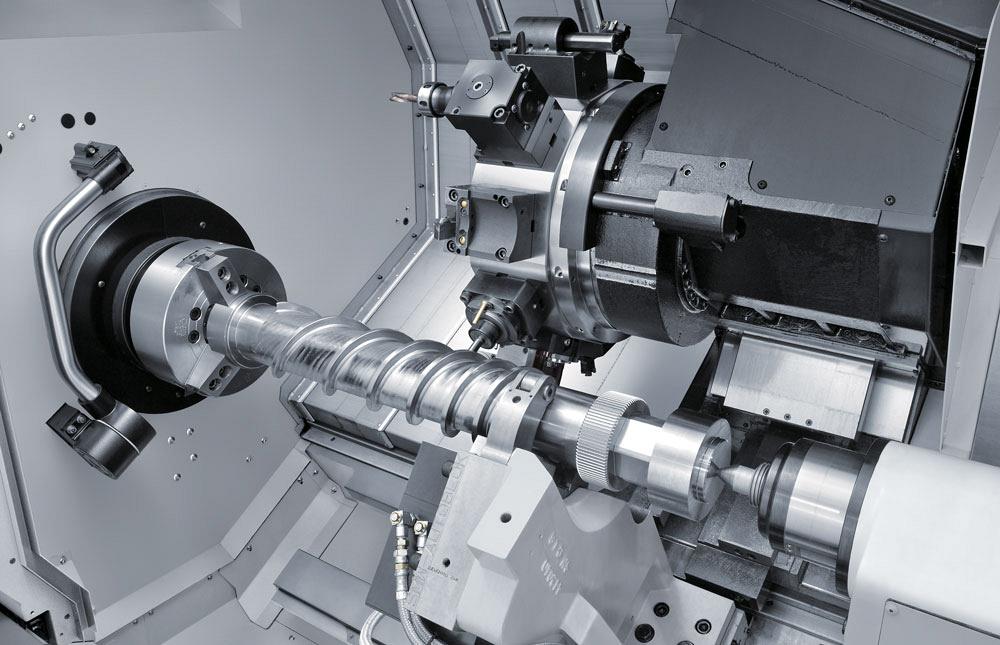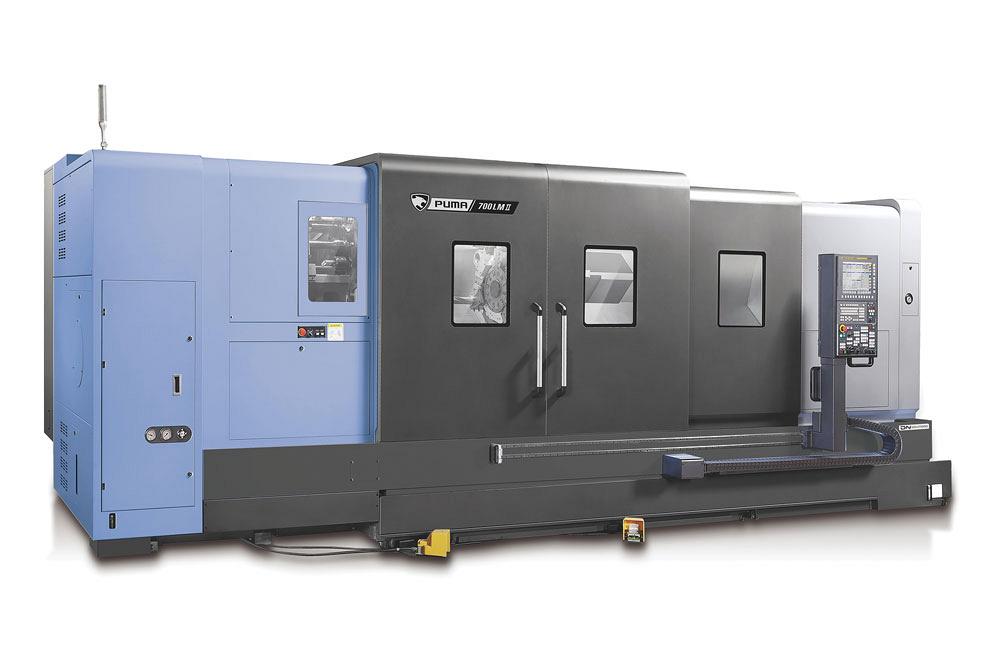Associate Editor
- FMA
- The Fabricator
- FABTECH
- Canadian Metalworking
Finding the right support in long-part turning
Turning long, thin parts can be a challenge without a support
- By Lindsay Luminoso
- January 4, 2024
- Article
- Metalworking

A single steady rest will support a part if done correctly. However, the longer the Z-axis travel, the more support is needed. DMG MORI
Machine shops are constantly looking for ways to increase their capabilities. As they move into higher length-to-diameter (L:D) parts, proper support becomes a significant factor.
Essentially, the radial cutting forces placed on barstock as it moves through the chuck can cause it to bend and the rotation of that bar, especially as the unsupported length increases, can cause a whipping effect.
For smaller length-to-diameter parts, the chuck may be enough to secure the part from these forces. For long, thin parts, other options may be needed to secure the length from these issues.
“One rule of thumb is that when you get to a length-to-diameter ratio that is more than 2.5, some sort of support may be needed,” said Siroos Askari, product manager, DMG MORI Canada, Mississauga, Ont. “Support can come in the form of tailstock or a steady rest. However, the longer the part, the more support will need to be concentrated in the middle.”
While 2.5:1 is a general baseline, some experts agree that there are some instances where a ratio of up to 5:1 overhang from the chuck can be machined without additional support.
“It’s more about knowing your part geometry and machine capability,” said Tom Shannon, sales manager Mazak Corp. Canada, Cambridge, Ont. “If you start drilling and see that the part is moving or deflecting, you are getting chatter. These are some telltale signs that you are not machining efficiently. Sometimes you can reduce feed speed to resolve the issues, but then you will be even less efficient. So, support might be necessary.”
There is a safety factor to consider as well. When a long, thin part is left without support, it can whip around and lead to an unsafe machining situation.
“You really need to contain any sort of whipping action to protect everybody in your shop,” said Carl Barthelson, regional sales manager, DN Solutions, Pine Brook, N.J. “This also will help ensure you are making good parts. Once your part starts to act like spaghetti, you’re obviously not making a straight part anymore. Finding the right support is essential for a number of reasons.”
Using a Tailstock
Support should be considered for any part that exceeds the 2.5 length-to-diameter ratio to maintain accuracy as well as a high surface finish quality.
“The first go-to support option is a tailstock,” said Shannon. “The tailstock is the most common support used, and there are very few turning centres and horizontal lathes today that do not have a tailstock option. The tailstock is used to support the end of the part where the chuck isn’t.”

Lathes with large work envelopes, like the Puma 700LM turning centre, often have standard steady rest brackets built into the machine. DN Solutions
Typically, the tailstock supports the part by using a live centre with a cone-shaped tip that can be placed into a centre hole of the workpiece to hold it in place between the chuck and the tailstock. The live centre’s tip is able to rotate, allowing for higher rotational speeds.
A manual tailstock can be adjusted by sliding it along a rail and then locking it into place. The challenge with a manual system is that because it relies on the operator to move it, it can be less accurate and require more fine-tuning to get it set up correctly.
“A programmable tailstock is a good option to consider,” said Barthelson. “It provides precise and automatic control of directional movement and holding pressure to support long parts. It also allows manufacturers to run lights out. Because it’s programmable, an operator doesn’t need to adjust it, it is built into the program, which can keep running.”
Askari added that a programmable tailstock is the best option of the two. It is much easier to work with and provides the flexibility that most machine shops are looking for.
A tailstock, in general, is great for a part that doesn’t require additional support in the middle of the workpiece. The higher the length-to-diameter ratio, the more difficult it becomes to use a tailstock by itself for support.
Using a Steady Rest
That’s where a steady rest comes in. A steady rest is a great option if operations need to be done at the end of the part or in the internal diameter (ID). However, because steady rests support both the bottom and top of the part, usually with rollers, this can cause problems for outer diameter (OD) operations across the length of the workpiece.
The experts agree that a few challenges arise when it comes to working with a steady rest. In some instances, the machine will not come with one. In other instances, operators may feel that they don’t need to use a steady rest—this is especially true if the machine doesn’t come with one built in.
“However, there are some telltale signs that signal a steady rest is needed,” said Barthelson. “When working on long parts, while the machine is working in the middle, if you encounter any vibration or notice issues with surface finish, that can indicate a lack of support and therefore a steady rest is needed.”
For the most part, there are two types of steady rests available: programmable and manual. The programmable option works with the machine program to automatically adjust and travel as the machine operates. A manual, or drag-and-drop option, requires the operator to set up every single part.
“Any diameter or size difference will cause the manual steady rest to be out of place relative to the centreline of the part, which is problematic,” said Shannon.

A rule of thumb is that when you get to a length-to-diameter ratio that is more than 2.5, some sort of support may be needed. DMG MORI
Lathes with larger work envelopes often have standard steady rest brackets built in. This makes it easy to use a steady rest or configure the machine for long, thin parts. Depending on the part geometry, operators can employ a few different strategies to ensure it is secure and supported.
“A single steady rest will support a part if done correctly,” said Askari. “The longer the Z-axis travel, the more support is needed. You could employ a twin steady rest strategy, where two steady rests are mounted on the same brackets. There is a double option, where the machine has two brackets with a steady rest on each bracket. This option allows for the steady rests to be moved separately across the Z-axis. Some shops, when they get into the 5 m. work envelopes, may employ three steady rests, each about a metre apart to support the entire length of travel.”
There are some other important factors to be aware of when working with a steady rest.
Shannon noted that when working with a sensitive part that cannot have marks on the surface, operators can add a fixture or segmented ring-type device to the part that allows the steady rest to roll on the ring and prevent marking.
When performing ID boring operations, it’s important to have a qualified surface on the part. Raw material often has rust or defects that can make clamping a challenge.
“Prep the material by adding a band, or a machined area, where the part can be clamped,” said Askari. “This is necessary when rotating the part.”
When it comes to OD work, a steady rest inherently makes travel across the entire length of the Z-axis a challenge. Because the steady rest is supporting the bar on both the top and bottom, the machine cannot work in the area that is clamped by the steady rest. In some instances, the operator must find a way to work around the steady rest without crashing into it, possibly even unclamping it, moving it, and reclamping it in another area of the part to work in the now accessible location.
“Chip control plays a huge role in the steady rests,” said Shannon. “Chips can get into the rollers, which can be tricky. Ensuring that there is enough coolant on the rollers to minimize chip interference is a must.”
It’s also important to ensure that the steady rest is the right size for the application. The larger the steady rest, the greater the risk of interference because it takes up more space and often costs more. However, a steady rest that is too small can limit application usage. Shops should find one that makes sense for what it is doing now and also can accommodate expanded capabilities in the future.
Using a Combination of Supports
There are some situations where both steady rests and tailstock are needed. According to Barthelson, having programmable rather than manual options enable lights-out operations and expands a shop’s capacity.
Depending on the L:D ratio, there could be a combination range, meaning that a shop could use a programmable tailstock and multiple steady rests. This applies only in situations where the part is extremely long and presents safety and machining challenges without using a combination.
The experts agree that the greater the L:D ratio, the more likely it is that additional support will be needed.
“The best-case scenario, when working with supports, is if you are working with a steady rest, that you should definitely look into having a programmable tailstock,” said Askari. “This way, everything is controlled using the one program. It just makes sense.”
Associate Editor Lindsay Luminoso can be reached at lluminoso@fmamfg.org.
DMG MORI Canada, ca-en.dmgmori.com
DN Solutions, www.dn-solutions.com
Mazak Canada, www.mazakcanada.com
About the Author

Lindsay Luminoso
1154 Warden Avenue
Toronto, M1R 0A1 Canada
Lindsay Luminoso, associate editor, contributes to both Canadian Metalworking and Canadian Fabricating & Welding. She worked as an associate editor/web editor, at Canadian Metalworking from 2014-2016 and was most recently an associate editor at Design Engineering.
Luminoso has a bachelor of arts from Carleton University, a bachelor of education from Ottawa University, and a graduate certificate in book, magazine, and digital publishing from Centennial College.
subscribe now


Keep up to date with the latest news, events, and technology for all things metal from our pair of monthly magazines written specifically for Canadian manufacturers!
Start Your Free Subscription- Trending Articles
Automating additive manufacturing

Sustainability Analyzer Tool helps users measure and reduce carbon footprint

CTMA launches another round of Career-Ready program

Sandvik Coromant hosts workforce development event empowering young women in manufacturing

GF Machining Solutions names managing director and head of market region North and Central Americas

- Industry Events
MME Winnipeg
- April 30, 2024
- Winnipeg, ON Canada
CTMA Economic Uncertainty: Helping You Navigate Windsor Seminar
- April 30, 2024
- Windsor, ON Canada
CTMA Economic Uncertainty: Helping You Navigate Kitchener Seminar
- May 2, 2024
- Kitchener, ON Canada
Automate 2024
- May 6 - 9, 2024
- Chicago, IL
ANCA Open House
- May 7 - 8, 2024
- Wixom, MI















